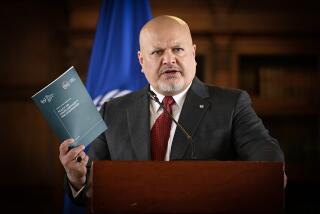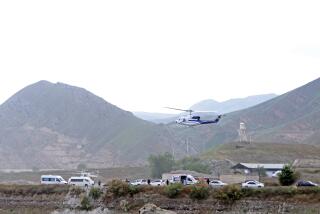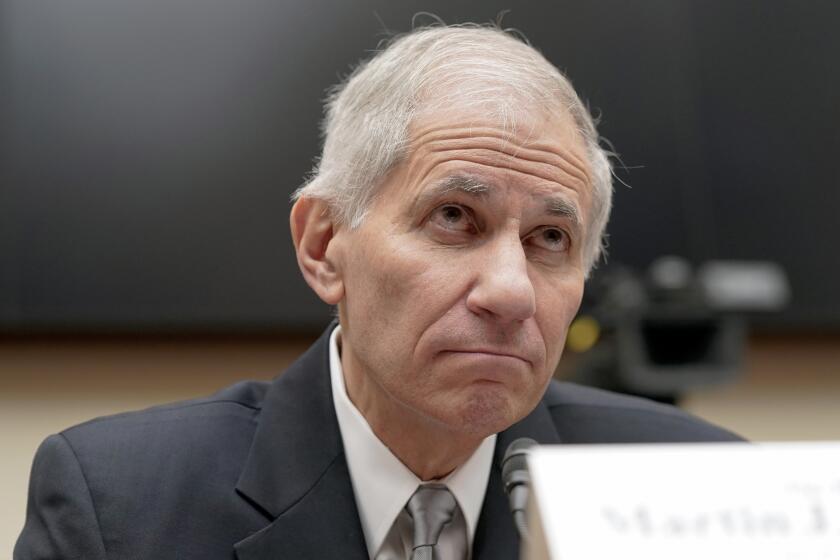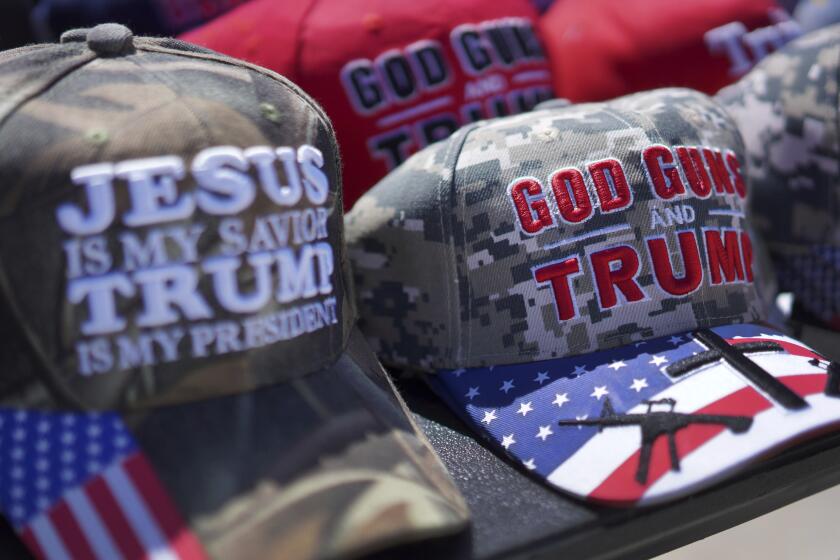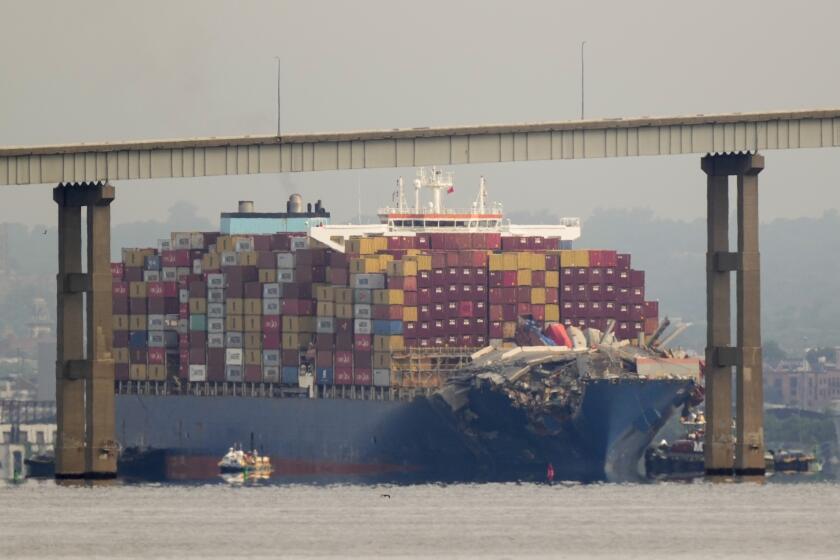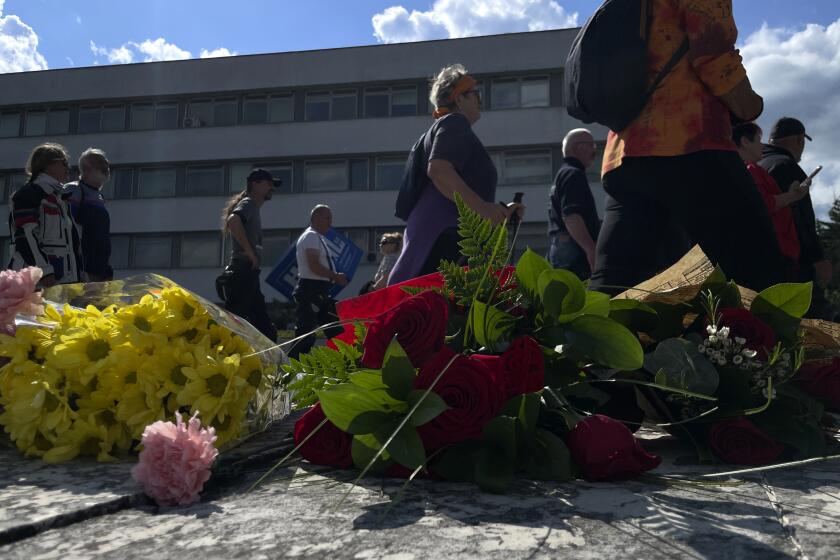Torched Flag Sparks Town to Examine Freedom
Ask people here about the flag on the mountain and they may shake their heads, grimace or just walk away.
But they all want to know why.
“No one can believe it,” said Wayne Sharrar, owner of Ol’ Time Barber Shop on Main Street. “Whoever did it was a coward.”
His client Gary Severson frowned.
“It’s deplorable,” he said.
Last weekend, the enormous American flag fluttering atop a local mountain to commemorate the Sept. 11 terrorist victims was slashed with knives and torched.
The culprit, who hiked at least four hours to get to the 12,805-foot peak, left a handwritten letter with a rambling denunciation of American foreign policy, the World Trade Organization and the International Monetary Fund. Accompanying the note was literature likening the flag to a Nazi swastika.
The incident stunned this laid-back ski town of 2,500 people where everyone seems to know their neighbors and extremists are as rare as a green Christmas. The 10-by-15-foot flag, residents say, was never meant to be an endorsement of any policy or leader; it simply marked the deaths of about 3,000 people.
“I know a lot of people may not like the flag, but to go all the way up there and do what they did is ridiculous,” said 34-year-old Kurt Kizer, who organized the flag-planting atop the mountain known as Peak One. “We did this as a memorial to those who died that day. We didn’t do it to support any administration or beliefs of any kind.”
Sitting at 9,100 feet, this former silver-mining town engulfed in the spires of the Rocky Mountains seems an unlikely place for a flag-burning. Not only is it remote and predominantly Republican, it also holds one of the largest Fourth of July celebrations in the region.
“I think the whole thing is tragic,” said 71-year-old Don Peterson, who flies a flag outside his house every day. “I’m an Air Force veteran, and it just burns me up.”
Summit County Sheriff Joseph Morales contacted the FBI because of the anti-American rhetoric in the letter and out of concern about who might be behind it. He said flag-burning, ruled legal by the U.S. Supreme Court, is a misdemeanor offense in Colorado, and he might use the statute to charge those responsible. He’s also considering filing arson and criminal mischief charges.
“I support freedom of speech but this is outrageous. It’s a knife at the heart of the community, and we won’t tolerate it,” said Morales, a Marine Corps veteran. “You just can’t burn other people’s property.”
Mark Silverstein, legal director for the American Civil Liberties Union of Colorado, said prosecuting someone for flag-burning would fail. Along with the U.S. Supreme Court, the Colorado Supreme Court ruled in 1973 that state statutes forbidding the mutilation or defilement of the flag were unconstitutional.
“Burning the flag to express an idea cannot be prosecuted; it’s protected by the 1st Amendment,” he said. “That doesn’t mean you can burn someone else’s flag. If you burn someone else’s flag you can be prosecuted under any number of statutes.”
Silverstein said notifying the FBI would be acceptable if there was evidence of terrorist links, not simply if someone questioned American policy.
“If the sheriff is taking expressions of disagreement with government policy as evidence of terrorist proclivity, then this is out of line,” he said. “Law enforcement needs to know the difference between dissent and terrorism.”
The White River National Forest, where the flag was burned, has had problems before. In 1998, members of the radical Earth Liberation Front, who recently took credit for burning SUVs as well as an apartment development in Southern California, claimed responsibility for setting fire to the Two Elk Lodge on a mountain near Vail, Colo.
They also ignited six other fires the same night, causing an estimated $12 million in damage.
Morales said his agency is trying to determine if there are any links between ELF and the recent incident.
The flag-burning is especially sensitive because of a recent controversy over whether it belonged on the summit.
Shortly after the Sept. 11 attacks, Kizer and other town residents put a flag on the mountain as a memorial. The flag could be seen from the highway and neighboring towns. U.S. Forest Service regulations prohibited memorials on public lands, but rangers chose to ignore the flag rather than invite controversy by taking it down.
This year, Kizer wanted to replace the flag, tattered after two years of exposure to the elements. The Forest Service initially balked but backed off after protests by town residents.
“Our supervisor stepped in and said this was a unique situation,” said Sue Froeschle, spokeswoman for the White River National Forest. “We have not made an exception; we are looking the other way.”
Not everyone was looking the other way.
On Sept. 12, Kizer and 25 others hiked to the peak, held a ceremony and erected a new flag. Sometime in the next two days it was burned.
“It’s ridiculous that someone got so upset that they went all the way up there to do that,” said Dave Philips, 47, part owner of a Frisco jewelry store. “If they are so angry, can’t they find a more constructive way of handling it? And I don’t think flag-burning should be illegal either.”
Tony Aveil, a 29-year-old Australian living in town, said the flag was part of life for the last two years.
“It symbolized a great tragedy, and for someone to burn it shows a lack of compassion,” he said. “Most people here are very relaxed and laid-back. I don’t know who would do it.”
The question now is whether a new flag will go up.
“It seems if we run back up there and put up a flag they will burn it down again,” Kizer said. “If they have an agenda, write to the local paper and tell us and we can talk about it. Until they can stand up for their cause, they are just vandals.”
More to Read
Start your day right
Sign up for Essential California for news, features and recommendations from the L.A. Times and beyond in your inbox six days a week.
You may occasionally receive promotional content from the Los Angeles Times.
